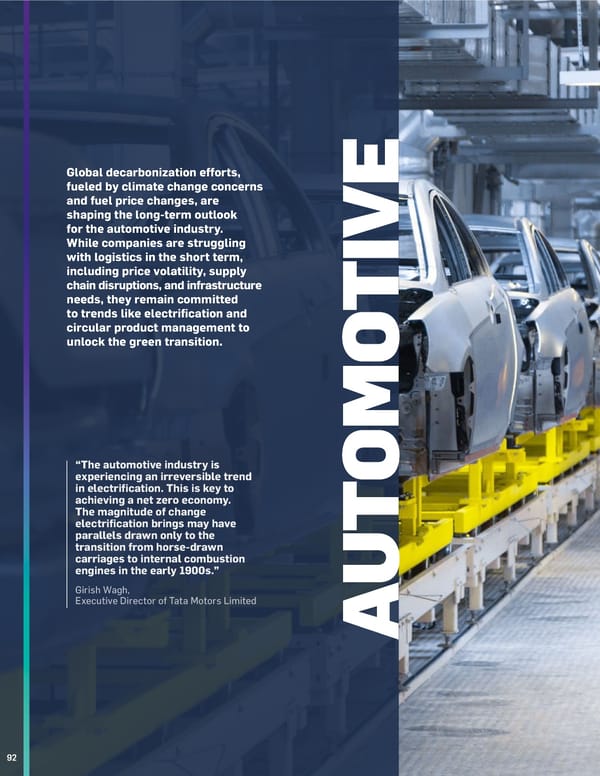T H E 1 2 T H U THE MOST PRESSING CHALLENGES AUTOMOTIVE CROSS INDUSTRY N I T E D N A 1 INFLATION & PRICE VOLATILITY 2 TALENT SCARCITY 3 THREATS TO PUBLIC HEALTH T I O N S G 11% L O B 4% 4% A L C O 68% 57% M 46% P 42% 44% 40% A Global decarbonization efforts, C T - E A fueled by climate change concerns C C E N and fuel price changes, are T U R shaping the long-term outlook CURRENT LANDSCAPE E C E for the automotive industry. V O S T While companies are struggling TOP RESILIENCE ACTIONS FOR AUTOMOTIVE CEOS U D with logistics in the short term, I Y of CEOs are of CEOs are of CEOs are including price volatility, supply digitizing upskilling or enhancing 78% 76% 69% chain disruptions, and infrastructure business processes reskilling their workforce for sustainability data needs, they remain committed the future labor market collection capabilities to trends like electrification and circular product management to The energy crisis, rising gas prices, limited access to materials such as nickel and lithium, coupled with consumer pressure to address unlock the green transition. climate change and increasing restrictions from governments, is fueling change in the automotive industry. As a first step, CEOs are looking to increase their digital and data capabilities to build a more resilient supply chain, as well as upskill their people to support a OT just transition. Companies are also investing in affordable and accessible EV charging infrastructure. As Mary Barra, General Motors’ Chair and Chief Executive Officer, states, “We want to help make sure that the transition to a more sustainable economy is inclusive, focusing especially on offering EVs across price points and segments, as well as convenient access to the charging infrastructure.” Yet, they are calling on government to support the broad infrastructure investments needed. To truly transform, the automotive industry will need to take an ecosystem approach, not only collaborating with governments, but also partnering with the utilities and energy M sectors to make EVs convenient and affordable for consumers. WHERE IS THE INDUSTRY GOING? TOP SUSTAINABILITY PRIORITIES FOR AUTOMOTIVE CEOS “The automotive industry is experiencing an irreversible trend of CEOs are of CEOs are of CEOs are upskilling their prioritizing prioritizing 79% 69% 59% in electrification. This is key to workforce for the future lowering GHG emissions constructing a responsible achieving a net zero economy. labor market supply chain The magnitude of change electrification brings may have TO parallels drawn only to the In the future, sustainability in the automotive industry will go beyond switching from fossil-fuel engines to EVs, to addressing the entire transition from horse-drawn lifecycle of a vehicle, from design and manufacturing through to end-of-life. Circular product management, supported by strong digital carriages to internal combustion and data management capabilities to enable traceability, is a promising solution for CEOs. It not only satisfies the growing focus on engines in the early 1900s.” U sustainability, but also addresses issues such as resource scarcity and price volatility of raw materials. Girish Wagh, Executive Director of Tata Motors Limited TRANSFORMATIVE INNOVATIONS A Electrification 64% Circular vehicle lifecycle management 63% Software-connected vehicles 58% Real-time supply chain data management 51% HIGH IMPACT MODERATE IMPACT LOW IMPACT NO IMPACT 92 93
 Accenture CEO Study United Nations Global Compact Page 91 Page 93
Accenture CEO Study United Nations Global Compact Page 91 Page 93